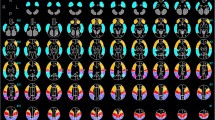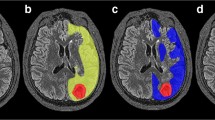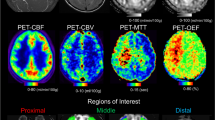Abstract
Purpose
[62Cu]Diacetyl-bis(N 4-methylthiosemicarbazone) (62Cu-ATSM) was used to evaluate brain haemodynamic impairment in patients with cerebrovascular disease (CVD) as a simplified evaluation method. The tracer distribution was compared with haemodynamic parameters obtained by 15O positron emission tomography (PET).
Methods
Ten patients with major cerebral arterial occlusive disease (aged 66 ± 7 years) underwent PET with 62Cu-ATSM and 15O tracers (15O-water, 15O2 and C15O). Seven healthy volunteers also underwent 62Cu-ATSM PET as normal controls. After the injection of 62Cu-ATSM, 20-min dynamic PET data acquisition was started. Early- and delayed-phase images of 62Cu-ATSM were obtained by averaging the initial 3-min and the last 10-min frame data, which were used for perfusion and retention images. Cerebral blood flow (CBF), blood volume, metabolic rate of oxygen (CMRO2) and oxygen extraction fraction (OEF) were measured by 15O-gas and water studies and compared with early- and delayed-phase 62Cu-ATSM images and delayed to early (D/E) ratio. Regional values were compared after all parametric images were coregistered to individual MRI. The asymmetry index (AI) was also calculated for OEF and Cu-ATSM D/E ratio, and diagnostic ability for detecting misery perfusion was compared.
Results
In the affected hemisphere of the patients, the mean values of haemodynamic parameters were CBF = 33.8 ± 5.9 ml/100 g per min, CMRO2 = 2.6 ± 0.3 ml/100 g per min and OEF = 48 ± 7%. Standardized uptake values (SUVs) for 62Cu-ATSM in early and delayed phases were 2.00 ± 0.13 and 1.04 ± 0.09 in the ipsilateral hemisphere and 2.13 ± 0.14 and 1.04 ± 0.08 in the contralateral hemisphere, respectively. The early-phase 62Cu-ATSM images corresponded well to CBF images, and the D/E ratio images were similar to OEF images. Regional values obtained from D/E ratio images were significantly correlated with regional OEF. AIs of OEF and D/E ratio showed a significant correlation and diagnostic ability of misery perfusion was slightly better in AI of D/E ratio than that of OEF.
Conclusion
Dynamic PET acquisition with 62Cu-ATSM provided information on CBF distribution and local elevation of OEF in patients with chronic CVD. The findings of the present study showed the feasibility of the noninvasive molecular imaging method for diagnosing misery perfusion with a single venous tracer injection.




Similar content being viewed by others
References
Grubb RL Jr, Derdeyn CP, Fritsch SM, Carpenter DA, Yundt KD, Videen TO, et al. Importance of hemodynamic factors in the prognosis of symptomatic carotid occlusion. JAMA 1998;280:1055–60.
Yamauchi H, Fukuyama H, Nagahama Y, Nabatame H, Ueno M, Nishizawa S, et al. Significance of increased oxygen extraction fraction in five-year prognosis of major cerebral arterial occlusive diseases. J Nucl Med 1999;40:1992–8.
Okazawa H, Kudo T. Clinical impact of hemodynamic parameter measurement for cerebrovascular disease using positron emission tomography and 15O-labeled tracers. Ann Nucl Med 2009;23:217–27.
Takasawa M, Moustafa RR, Baron JC. Applications of nitroimidazole in vivo hypoxia imaging in ischemic stroke. Stroke 2008;39:1629–37.
Markus R, Reutens DC, Kazui S, Read S, Wright P, Chambers BR, et al. Topography and temporal evolution of hypoxic viable tissue identified by 18F-fluoromisonidazole positron emission tomography in humans after ischemic stroke. Stroke 2003;34:2646–52.
Sarrafzadeh AS, Nagel A, Czabanka M, Denecke T, Vajkoczy P, Plotkin M. Imaging of hypoxic-ischemic penumbra with 18F-fluoromisonidazole PET/CT and measurement of related cerebral metabolism in aneurysmal subarachnoid hemorrhage. J Cereb Blood Flow Metab 2010;30:36–45.
Read SJ, Hirano T, Abbott DF, Sachinidis JI, Tochon-Danguy HJ, Chan JG, et al. Identifying hypoxic tissue after acute ischemic stroke using PET and 18F-fluoromisonidazole. Neurology 1998;51:1617–21.
Read SJ, Hirano T, Abbott DF, Markus R, Sachinidis JI, Tochon-Danguy HJ, et al. The fate of hypoxic tissue on 18F-fluoromisonidazole positron emission tomography after ischemic stroke. Ann Neurol 2000;48:228–35.
Markus R, Reutens DC, Kazui S, Read S, Wright P, Pearce DC, et al. Hypoxic tissue in ischaemic stroke: persistence and clinical consequences of spontaneous survival. Brain 2004;127:1427–36.
Markus R, Donnan G, Kazui S, Read S, Reutens D. Penumbral topography in human stroke: methodology and validation of the ‘Penumbragram’. Neuroimage 2004;21:1252–9.
Bruehlmeier M, Roelcke U, Schubiger PA, Ametamey SM. Assessment of hypoxia and perfusion in human brain tumors using PET with 18F-fluoromisonidazole and 15O-H2O. J Nucl Med 2004;45:1851–9.
Fujibayashi Y, Taniuchi H, Yonekura Y, Ohtani H, Konishi J, Yokoyama A. Copper-62-ATSM: a new hypoxia imaging agent with high membrane permeability and low redox potential. J Nucl Med 1997;38:1155–60.
Takahashi N, Fujibayashi Y, Yonekura Y, Welch MJ, Waki A, Tsuchida T, et al. Evaluation of 62Cu labeled diacetyl-bis(N4-methylthiosemicarbazone) as a hypoxic tissue tracer in patients with lung cancer. Ann Nucl Med 2000;14:323–8.
Dehdashti F, Mintun MA, Lewis JS, Bradley J, Govindan R, Laforest R, et al. In vivo assessment of tumor hypoxia in lung cancer with 60Cu-ATSM. Eur J Nucl Med Mol Imaging 2003;30:844–50.
Dehdashti F, Grigsby PW, Lewis JS, Laforest R, Siegel BA, Welch MJ. Assessing tumor hypoxia in cervical cancer by PET with 60Cu-labeled diacetyl-bis(N4- methylthiosemicarbazone). J Nucl Med 2008;49:201–5.
Lohith TG, Kudo T, Demura Y, Umeda Y, Kiyono Y, Fujibayashi Y, et al. Pathophysiologic correlation between 62Cu-ATSM and 18F-FDG in lung cancer. J Nucl Med 2009;50:1948–53.
Fujibayashi Y, Cutler CS, Anderson CJ, McCarthy DW, Jones LA, Sharp T, et al. Comparative studies of Cu-64-ATSM and C-11-acetate in an acute myocardial infarction model: ex vivo imaging of hypoxia in rats. Nucl Med Biol 1999;26:117–21.
Takahashi N, Fujibayashi Y, Yonekura Y, Welch MJ, Waki A, Tsuchida T, et al. Copper-62 ATSM as a hypoxic tissue tracer in myocardial ischemia. Ann Nucl Med 2001;15:293–6.
Obata A, Yoshimi E, Waki A, Lewis JS, Oyama N, Welch MJ, et al. Retention mechanism of hypoxia selective nuclear imaging/radiotherapeutic agent Cu-diacetyl-bis(N4-methylthiosemicarbazone) (Cu-ATSM) in tumor cells. Ann Nucl Med 2001;15:499–504.
Ikawa M, Okazawa H, Arakawa K, Kudo T, Kimura H, Fujibayashi Y, et al. PET imaging of redox and energy states in stroke-like episodes of MELAS. Mitochondrion 2009;9:144–8.
Powers WJ. Cerebral hemodynamics in ischemic cerebrovascular disease. Ann Neurol 1991;29:231–40.
DeGrado TR, Turkington TG, Williams JJ, Stearns CW, Hoffman JM, Coleman RE. Performance characteristics of a whole-body PET scanner. J Nucl Med 1994;35:1398–406.
Matsumoto K, Fujibayashi Y, Yonekura Y, Wada K, Takemura Y, Konishi J, et al. Application of the new zinc-62/copper-62 generator: an effective labeling method for 62Cu-PTSM. Int J Rad Appl Instrum B 1992;19:39–44.
Okazawa H, Yamauchi H, Sugimoto K, Takahashi M, Toyoda H, Kishibe Y, et al. Quantitative comparison of the bolus and steady-state methods for measurement of cerebral perfusion and oxygen metabolism: positron emission tomography study using 15O-gas and water. J Cereb Blood Flow Metab 2001;21:793–803.
Okazawa H, Tsuchida T, Kobayashi M, Arai Y, Pagani M, Isozaki M, et al. Can the detection of misery perfusion in chronic cerebrovascular disease be based on reductions in baseline CBF and vasoreactivity? Eur J Nucl Med Mol Imaging 2007;34:121–9.
Okazawa H, Kishibe Y, Sugimoto K, Takahashi M, Yamauchi H, et al. Delay and dispersion correction for a new coincidental radioactivity detector, Pico-Count, in quantitative PET studies. In: Senda M, editor. Brain imaging using PET. San Diego: Academic; 2002. p. 15–21.
Raichle ME, Martin WR, Herscovitch P, Mintun MA, Markham J. Brain blood flow measured with intravenous H2 15O. II. Implementation and validation. J Nucl Med 1983;24:790–8.
Mintun MA, Raichle ME, Martin WR, Herscovitch P. Brain oxygen utilization measured with O-15 radiotracers and positron emission tomography. J Nucl Med 1984;25:177–87.
Isozaki M, Arai Y, Kudo T, Kiyono Y, Kobayashi M, Kubota T, et al. Clinical implication and prognosis of normal baseline cerebral blood flow with impaired vascular reserve in patients with major cerebral artery occlusive disease. Ann Nucl Med 2010;24:371–7.
Kobayashi M, Kudo T, Tsujikawa T, Isozaki M, Arai Y, Fujibayashi Y, et al. Shorter examination method for the diagnosis of misery perfusion using count-based oxygen extraction fraction elevation in 15O-gas PET. J Nucl Med 2008;49:242–6.
Saita K, Chen M, Spratt NJ, Porritt MJ, Liberatore GT, Read SJ, et al. Imaging the ischemic penumbra with 18F-fluoromisonidazole in a rat model of ischemic stroke. Stroke 2004;35:975–80.
Takasawa M, Beech JS, Fryer TD, Hong YT, Hughes JL, Igase K, et al. Imaging of brain hypoxia in permanent and temporary middle cerebral artery occlusion in the rat using 18F-fluoromisonidazole and positron emission tomography: a pilot study. J Cereb Blood Flow Metab 2007;27:679–89.
Acknowledgements
The authors wish to thank Dr. Tsuneo Saga, Dr. Toshimitsu Fukumura and other staff at the Molecular Imaging Center, National Institute of Radiological Sciences. The authors also thank the staff of Biomedical Imaging Research Center, University of Fukui, Fukui for clinical and technical support. This study was partly funded by a Grant-in-Aid for Scientific Research from the Japan Society for the Promotion of Science (17209041, 17209040, 20249055), and 21st Century COE Program (Medical Science).
Conflicts of interest
None.
Author information
Authors and Affiliations
Corresponding author
Rights and permissions
About this article
Cite this article
Isozaki, M., Kiyono, Y., Arai, Y. et al. Feasibility of 62Cu-ATSM PET for evaluation of brain ischaemia and misery perfusion in patients with cerebrovascular disease. Eur J Nucl Med Mol Imaging 38, 1075–1082 (2011). https://doi.org/10.1007/s00259-011-1734-z
Received:
Accepted:
Published:
Issue Date:
DOI: https://doi.org/10.1007/s00259-011-1734-z




